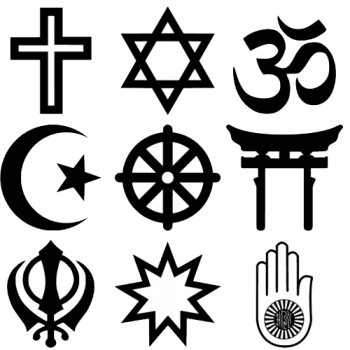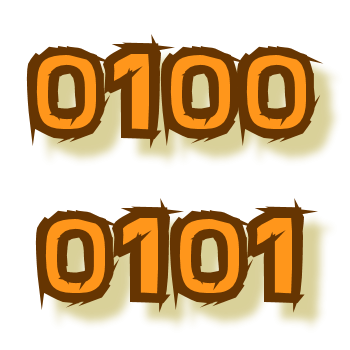Ask Professor Puzzler
Do you have a question you would like to ask Professor Puzzler? Click here to ask your question!
Dear Professor Puzzler, I read that if a polynomial equation has degree 2, there are two solutions, if it's degree three, there are three solutions, and so on. Is this true? Lucia
Well, Lucia,
It's true, and it's not true. It's true, with a couple of clarifications. Let's take a look to see a couple examples.
Example One: A Perfect Square
x2 + 6x + 9 = 0
How does this factor?
(x + 3)(x + 3) = 0, or (x + 3)2 = 0.
This gives us only one solution: x = -3. So the rule you read isn't exactly right in this case.
Example Two: A "Complex" Polynomial
Consider this one: x2 + 9 = 0.
This can't be factored, and yet, if you know complex numbers, you can do this to it:
x2 = -9
x = 3i or -3i.
So we need to revise your rule a bit:
If you have a polynomial equation with degree n (n a positive integer), the number of solutions is n, as long as we agree to count repeated solutions once for each occurrence, and we allow for complex solutions.
So, for example, if you have an ugly polynomial like this:
x5 - 3x4 + 7x3 - 13x2 + 12x - 4 = 0
It can be factored as follows: (x - 1)3(x + 2i)(x - 2i) = 0.
The solutions are: 2i, -2i, 1, 1, and 1, for a total of 5 solutions, which matches the degree of the polynomial.
By the way, if you're wondering how I factored x5 - 3x4 + 7x3 - 13x2 + 12x - 4, that's a post for another day!
Professor Puzzler
7th grader Colleen from Oregon asks, "How many people believe in god?"
Hi Colleen, I'm guessing you mean "how many people world-wide believe in a god or gods of some sort?"

That's a pretty tough question, but to help me out I visited a site called "Pew Research." They are an organization that does studies on a wide variety of social, political and religious trends. From their "Religion and Public Life" section of their site, you will find that a recent statistical study showed that about 83% of the world's population considers themselves to be affiliated with a specific religion. Christianity, Islam, Buddhist, Jewish, and various folk/traditional religions (for folk religions, think of a group of ethnically and geographically connected people who have a traditional - but usually unwritten - set of beliefs passed down from one generation to another).
So it seems like a vast majority of the world's population believes in a god or gods. However, it's interesting to note that in a separate study, in which they asked respondents how strongly they believe in God, Pew Research discovered that only about two thirds of the U.S. population confidently believes in God. Many other people gave responses like "I think there's a God, but I'm not sure."
Thus, there's a fairly good sized section of the population who identifiy with a particular church or religion, but aren't convinced there's actually a god. Why? Perhaps they see the church as a sort of "social club," or perhaps they are trying to figure out what they believe, and are associating themselves with a church in hopes that it will help them settle their religious questions/doubts.
Also, it's important to keep in mind that not all the religions that Pew included in their study have a "god" in the sense that you might think of it. For example, Buddha rejected the concept of a creator god, and Buddhism is described sometimes as a nontheistic religion. Similarly, many of the folk religions are nontheistic in nature as well. This means that the 83% obtained by Pew Research includes large populations which adhere to a religion but do not believe in God.
If I had to make a guess (and since you asked me, I guess I will!) I would say that the actual percent is closer to 60 than 80. So let's say 2/3 of the world's population. Since the population of the world is approaching 8 billion, I would put my wild guess somewhere in the vicinity of 5 billion people who, with a reasonable degree of confidence, believe in a god or gods.
Thanks for asking!
Professor Puzzler
PS - the picture shown above is a public domain image by Rursus, which contains symbols from 9 of the world's most widely held religions:
- 1st Row: Christian, Jewish, Hindu
- 2nd Row: Islam, Buddhist, Shinto
- 3rd Row: Sikh, Bahai, Jain

Emmanuel from Nigeria asks, "How are letters converted into binary codes?"
Well, Emmanuel, I'm guessing you came here from our Binary Coding Page. If so, you ask an excellent question, because the subject of how we convert letters is not really explained there.
The big question is, "How do you convert a letter to a number?" Because if you can convert the letter to a number, then you can use the information on our base conversion page to convert that number into binary. So how does the computer do the conversion from letter to number?
There is a standard listing called the "ASCII Character Set," in which every character used on a computer's keyboard is assigned a number. There are a lot of these characters, because there isn't just one for every key on your keyboard - there's also one for each key with the SHIFT key pressed. The ASCII character set has room for 256 characters, numbered from 0 to 255.
You might wonder, "Why 256?" and the answer is, because 256 = 28, which means anything less than 256 can be written as 8 binary bits (place values). Each character needs to have the same number of binary bits - otherwise nobody would know where one character ends and the next one starts. So even though the number 15 only needs four bits to be written in binary (1111two) in order to make sure all the numbers have the same length, the computer would write it as 0000 1111two. We put a space between every four digts, for the same reason that we do commas in base ten - it helps us read long strings of digits more easily.
Okay, so with that out of the way, now we just need to know what letters are represented by what number. Here's a quick reference for you:
A = 65
B = 66
C = 67
...
X = 88
Y = 89
Z = 90
Remember I mentioned that the ASCII Codes account for the shift key? That means that lower case letters have a different number assigned than upper case letters:
a = 97
b = 98
c = 99
...
x = 120
y = 121
z = 122
Now, there are a couple things you might have wondered about, like "What comes before 65?" and "Why is there a gap between the upper and lower case numbers?"
The answer to the first question is, there are other characters in those gaps - numbers, punctuation, special control characters (like the Backspace, Enter, Delete, etc).
The reason there's a gap between the upper case and lower case alphabets is that it makes "a" 32 more than "A." That is very convenient because 32 is a power of 2 (25), so changing between upper and lower case means changing just one bit:
A = 0100 0001
a = 0110 0001
So if you're using the computer's ASCII character set, and you wanted to convert "Hello" into binary, you would look up each letter in the ASCII chart:
H = 72 = 0100 1000two
e = 101 = 0110 0101two
l = 108 = 0110 1100two
l = 108 = 0110 1100two
o = 111 = 0110 1111two
So the entire word "Hello" is:
0100 1000 0110 0101 0110 1100 0110 1100 0110 1111two.
BUT...you don't have to use the ASCII conversion; you could create your own way of converting letters to numbers. Why would you want to do that? Well, you probably wouldn't, unless you wanted to conserve space, and you didn't care about anything except the basic upper case alphabet.
You see, if all you cared about was the upper case letters (and maybe a space), then you could do a conversion like this:
SPACE = 0
A = 1
B = 2
C = 3
...
X = 24
Y = 25
Z = 26
Why would you want to do that? Because now your biggest number you need to encode is 26, which is less than 25. That means that you only need five digits to write each number instead of eight! So your encoded message will take up 5/8 as much space. You'll save about 38% of the space on the page.
Since you have to have space in your table for 32 characters, and you've only used up to 26, you might as well use the other ones. Maybe include some punctuation?
COMMA = 27
PERIOD = 28
QUESTION MARK = 29
DASH = 30
DOLLAR SIGN = 31
Or you could create a table with 64 characters, which would either let you put in a lot more punctuation, or the numbers, or the lower case alphabet. But now you're using six binary digits per character, so you're not saving as much space.
Or you could completely jumble your character chart, which makes it a harder for other people to decode:
A = 17
B = 3
C = 25
etc...
But if you really want to make a coded message, there are much better ways to do it, so everyone just sticks with the standard ASCII codes in order to keep things simple.
A couple more things:
- The ASCII chart is available online; just go to google and search for "ASCII codes" and you'll get the entire list!
- ASCII stands for "American Standard Code for Information Interchange"
Thanks for asking, Emmanuel. I probably gave you much more information than you were expecting, but I hope you found it both interesting and helpful!
Professor Puzzler
PS - you can find more information about encoding here: Colors, Numbers, and Graphemes.
Fifth grader Chas asks, "Is there only one way to create a factor tree, and why?"
Hi Chas, most numbers have more than one way to do a factor tree, but each factor tree gives the same prime factorization in the end. Let's take an example, so you can see what I mean. How would you like to do a factor tree for 72?
72 factors into 8 and 9, 8 factors into 4 and 2, 9 factors into 3 and 3, and 4 factors into 2 and 2. So the factor tree looks like this:
72
/ \
8 9
/ \ / \
4 2 3 3
/ \
2 2
So 72 factors into 2 x 2 x 2 x 3 x 3, or 2332.
But there really isn't any reason that we started by splitting 72 into 8 and 9 (other than, perhaps, 8 x 9 = 72 is in the multiplication tables I memorized back when I was your age, so it was the first thing that popped into mind). Can you think of another pair of numbers that multiply to 72? I thought of 36 and 2. So we could do the factor tree this way instead:
72
/ \
36 2
/ \
6 6
/ \ / \
3 2 3 2
This factor tree looks very different from the first one, doesn't it? And yet, there are still 3 twos and 2 threes, giving us the same prime factorization: 2 x 2 x 2 x 3 x 3, or 2332.
Is this always going to work? Yes! It doesn't matter how you split things up, and it doesn't matter how different your factor trees look. Every number has exactly one way of splitting it into prime factors, so the prime factorization will be the same no matter how you do the number's prime factorization.
And by the way, if you're nervous about doing a prime factorization wrong, this is a good way to check your work: do the factor tree, and then go back and do it a second time, only this time think of a different way of factoring the number. You'll have two different factor trees, but if you get the same prime factorization at the end, you can feel more confident that you got it right.
Of course, if you don't get the same factorization, you'll know you did something wrong, and you need to go back through your work to find out where you went wrong!
Have fun factoring, Chas!
Professor Puzzler

One of the first things I do every year when I realize that the new year upon us...
...no, not New Year's resolutions.
No, I always reduce the new year to its prime factorization. Why? Because sometimes I write competition math problems involving the school year, and so it's nice to know how the number factors.
In case you were wondering, 2016 = 25327.
It's also, by the way, 25 less than 211. That's right - in 32 more years, the year number will be a perfect 11th power.
And if you want to verify that without using a calculator:
25327 + 25 = 25(327 + 1) = 25(63 + 1) = 2526 = 211.
Obviously, even when I'm on school vacation, my math mind doesn't shut down. In fact, I just spent a good part of a day writing a math unit that some of my high school students will be working on later on this year: Probability. This unit covers essential concepts like dependent and independent events, mutually exclusive outcomes, complementary outcomes, and compound events. There may eventually be a second probability unit that delves into more topics, such as conditional probability. For now, if you're looking for basic concepts, this is a good starting point.
Meanwhile, a unit on Pythagorean Means has also been added to the site.
It seems that some of you haven't left behind your math brains while on Christmas vacation, either. Professor Puzzler has fielded a handful of math-related questions while on vacation:
- Why Can't I Divide by Zero?
- Why Does Cryptology Exist?
- What Are Telescoping Series?
- What Does the Upper-Case Pi Mean?
Thanks for all the great questions!
Happy 211 - 25,
Douglas Twitchell
TPS Admin


